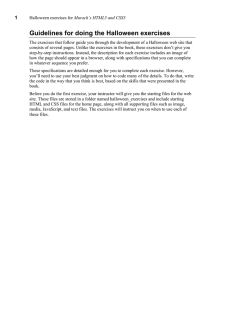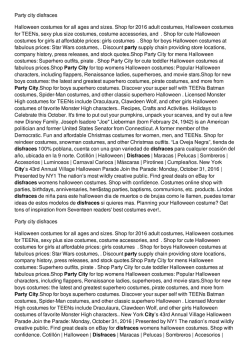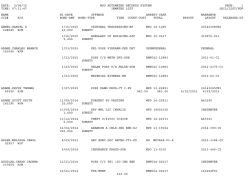
Current Newsletter - TRCIDKC.org
Halloween Supersticiones Halloween siempre ha sido una fiesta llenada de misterio, magia y supersticion. Comenzo como una fiesta celta de fin de verano durante el cual la gente se sintio especialmente a los difuntos familiars y amigos. Para estos espiritus amistosos, fijaron lugares en la mesa izquierda trata a puertas y a lo largo del lado de la carretera y velaspara ayudar a sus seres queridos encontrar su camino de vuelta al mundo espiritual. Halloween hoy fantasmas a menudo se describen como mas temible y malevolos, y nuestros trajes y las supersticiones son mas temibles. Evitar cruce de vias con los gatos negros, miedos tal vez nos traen mala suerte. Esta idea tiene sus raices en la edad media, cuando muchas personas creian Brujas evitar la deteccion por convirtiendose ellos mismos en los gatos. No tratamos de caminar bajo las escaleras por las mismas razones. Esta supersticion puede provenir de los antiguos egipcios que creian triangulos eran sagrados. Tambien puede tener algo que ver con el hecho de que caminar bajo una escalera inclinada tiende a ser bastante inseguro. Y alrededor de Halloween tratamos de evitar romper los espejos, pisando las grietas en la carretera o derramar sal. Truman CEM N A H N E Road m Com Montado sobre la linea entre el otono y el invierno, abundancia y escasez, vida y munerte, Halloween es un momento de celebracion y la supersticion. Ha pensado que se origino con el antiguo festival Celta de Samhain, cuando la gente enciende hogueras y trajes para alejar los fantasmas de itinerancia. En el Siglo VIII, designado el l de Noviembre el Papa Gregory III comotiempo para honrar a todos los Santos y martires; Todas los Santos, incorporo algunas de la tradiciones o Samhain. La noche anterior era conocida como de los huecos la vispera y mas adelante Halloween. En un numero de paises alrededor del mundo, como los dias cercen mas cortos y las noches ponerse frias, continuan el comienzo de la temporada de invierno. Durante milenios las vacaciones de la transicion de un ritual pagano sombrio a un dia de alegria, disfraces, desfiles y dulcet rata para ninos y adultos. Celebracion de Halloween fue extremadamente limitado en colonial Nueva Inglaterra debido a los sistemas de creencias protestantes rigido alli. Halloween era mucho mas comun en Maryland y las coloniasdel sur. Una version distintamente Americana de Halloween comenzaron a surgir. L:as primeras celebraciones americanas incluyen “jugar partidos”, lleva a cabo eventos publicos para celebrar la cosecha, donde los vecinos comparten historias de los muertos, Buenaventura mutuamente, bailar y cantar. Fiestas de Halloween colonial conto tambien con la narracion de historias de fantasmas y travesuras de todo tipo. La tracicion de vestirse con traje de Halloween tiene tanto Europea como Celta se pude. En Halloween cuando se creia que los fantasmas ha vuelto al mundo terrenal, la gente penso que detecarian a los fantasmas si abandonaron sus hogares. Para evitar ser reconocido por esos fantasmas, gente usaria mascaras cuando abandonaron sus hogares por la noche para que los fantasmas les tomaria por espiritus companeros. En Halloween,para alejar los fantasmas de sus casas, gente pondria los tazones de fuente de alimentacion fuera de sus casas para apaciguar a los fantasmas y les impiden intentar entrar. La tradicion o caramelos probablemente se remonta a los primeros desfiles del dia de los muertos en Inglaterra. Durante las fiestas, los cuidadanos pobres que mendigan comida y familias les daria pastels llamados “dortas de alma” a cambia de su promesa de rezar por los parientes muerto de la familia. La practica que fue referido como “va a souling” fue finalmente tomada por ninos que visitan las casas en sus vedindarios y dara cerzveza, comida y dinero. Con el tiempo las vacaciones de la transicion de un ritual pagano sombrio a un dia de alegria, disfraces, desfiles y dulcet rata para ninos y adultos. Feliz Halloween ION T C A ENT IN un it Di str ict • HALLOWEEN HALLOWEEN nt e y Im m prove • VOLUME 6 ISSUE 10 OCTOBER 2014 Next Stop World Series Straddling the line between fall and winter, plenty and paucity, life and death, Halloween is a time of celebration and superstition. It’s thought to have originated with the ancient Celtic festival of Samhain, when people would light bonfires and wear costumes to ward off roaming ghosts. In the eighth century, Pope Gregory III designated November 1 as a time to honor all saints and martyrs; All Saints’ Day, incorporated some of the traditions of Samhain. The evening before was known as All Hollows’ Eve and later Halloween. In a number of countries around the world, as the days grow shorter and the nights get longer, people continue to usher in the winter season. INSIDE THIS ISSUE Over the millennia the holiday transitioned from a somber pagan ritual to a day of Halloween Superstitions merriment, costumes, parades and sweet treats for children and adults. What TRCID Does Celebration of Halloween was extremely limited in colonial New England because of TRCID Board the rigid Protestant belief systems there. Halloween was much more common in Leaves & Limbs Maryland and the southern colonies. A distinctly American version of Halloween began Yard Raking to emerge. Streetcar Tribute The first American celebrations included “play parties”, public events held to Spanish Page celebrate the harvest, where neighbors share stories of the dead, tell each other’s fortunes, dance and sing. Colonial Halloween festivities also featured the telling of ghost stories and mischief-making of all kinds. The tradition of dressing in costume for Halloween has both European and Celtic roots. On Halloween when it was believed that ghosts came back to the earthly world, people thought that they would encounter ghosts if they left their homes. To avoid being recognized by those ghosts, people would wear masks when they left their homes after dark so the ghosts would mistake them for fellow spirits. On Halloween, to keep ghosts away from their houses, people would place bowls of food outside their homes to appease the ghosts and prevent them from attempting to enter. The tradition of trick-or-treating probably dates back to the early All Souls’ Day parades in England. During the festivities, poor citizens would beg for food and families would give them pastries called “soul cakes” in return for their promise to pray for the family’s dead relatives. The practice, which was referred to as “going a-souling” was eventually taken up by children who would visit the houses in their neighborhoods and be given ale, food and money. Over time the holiday transitioned from a somber pagan ritual to a day of merriment, costumes, parades and sweet treats for children and adults. Happy Halloween 2 2 2 3 3 3 4 • PAGE 2 ENHANCEMENT IN ACTION HALLOWEEN SUPERSTITIONS Halloween has always been a holiday filled with mystery, magic and superstition. It began as a Celtic end-of-summer festival during which people felt especially close to deceased relatives and friends. For these friendly spirits, they set places at the dinner table, left treats on doorsteps and along the side of the road and lit candles to help loved ones find their way back to the spirit world. Today’s Halloween ghosts are often depicted as more fearsome and malevolent, and our costumes and superstitions are scarier too. We avoid crossing paths with black cats, afraid they might bring us bad luck. This idea has its roots in the middle ages when many people believed witches avoided detection by turning themselves into cats. We try not to walk under ladders for the same reasons. This superstition may have come from the ancient Egyptians who believed triangles were sacred. It also may have something to do with the fact that walking under a leaning ladder tends to be fairly unsafe. And around Halloween we try to avoid breaking mirrors, stepping on cracks in the road, or spilling salt. Have a safe and happy Halloween! WHAT THE TRUMAN ROAD COMMUNITY IMPROVEMENT DISTRICT DOES: 1. We work with the KC Crime Commission, MCSP Division as a community services station (where people work off their community service hours). These people work off their hours while collecting trash, tires and bulk items. 2. Trash, tires and bulk items are collected on Mondays, Wednesdays & Fridays. The areas covered are from White St. (near Topping) to Indiana, and from 12th St. to Truman Road. Periodically we additionally pick up from QuikTrip near 435 to the Sprint Center on Truman Road. Since April 14th, 2010 we have collected over 10,000 bags of trash and almost 4500 tires, with additional “bulk” items such as discarded television sets, clothing, and small household items. 3. Graffiti abatement is done within our identified geographic area. We purchase city-collected recycled paint from HasMat at $15/5-gal pail. We also supply the brushes, rollers and misc. painting materials. This includes graffiti on bridges, businesses, signs, walls, and fences. 4. The Truman Road CID pays for and provides security patrols to the CID member businesses through contracted NKC Federal Bureau of Investigation. They work (24) hours per week – Fridays, Saturdays, Sundays, and (1) “floater” day during the week. The company maintains a close association with East Patrol, reporting and/or assisting as needed. They look for and report open doors, unlocked gates, broken windows, lights out, and trespassing. Loitering has also been greatly reduced. 5. Since its beginning, our CID has planted and maintained over 100 trees along Truman Road at our expense. 6. The CID recently spent $37,000 on landscaping and flower beds. (CID paid for). 7. In the winter, sidewalk snow removal is contracted at CID expense. This extends uninterrupted from White St. to Indiana on both sides of the street. 8. We have installed (40) street banners on city poles (through permit and $ deposit with the city). Items #1, #2 and #3 are accomplished with community service labor. Offenders work off their hours while provided valuable neighborhood and community services. All (8) items are done at no cost to the city. We also work closely with neighborhood associations, East Patrol (safety & security), the Northeast Chamber of Commerce, and attend monthly meetings with the Main Street Corridor Assn. and are on the KC Crime Commission board. TRUMAN ROAD CID BOARD The Truman Road Community Improvement District (TRCID) is seeking possible candidates for board membership. You must be a property owner or business owner/manager along or near Truman Road. If you wish to be considered for the board of an established and progressive CID, please call Dick Bassett at (913) 908-4941. All inquiries are welcome • PAGE 3 Leaves & Limbs? So what do you do with them? We’re now into Fall and you may have leaves and limbs to dispose of. Kansas City offers (2) drop-off sites as well as two curbside leaf, limbs and brush collections. For a small fee you can dispose of them on Wednesdays, Thursdays, Fridays and Sundays. One site is at 1815 N. Chouteau Trafficway. The second is just South of I-470 on the East side of Raytown Road. The second will be open on Saturdays only. Both sites are open from 8:00AM to 5:00PM. Dispose of your leaves, branches and brush in a responsible manner. Please use one of these two sites. Help us keep our Truman Road corridor and surrounding neighborhoods clean and maintained. YARD RAKING FOR SENIORS KC Rakes provides free yard raking services for adults over the age of (65) who own their own home, cannot afford to pay for yard services, don’t have family who can assist them, and who can no longer do yard work on their own. The service is offered once a year in November by the Shephard’s Center. Registration and volunteer sign-up began October 1st. For more information contact Deb Dickinson, Manager of Volunteers, at (816) 444-1121, ext 105. Deb’s web site is [email protected]. STREETCAR TRIBUTE (A ND BRIEF HISTORY) Streetcar #1056 is being painted in tribute to Kansas City, which ran PCC streetcars from 1941 to 1957. Kansas City’s PCC’s – 184 in all – were painted to emphasize their modern lines, with a black “swosh” on the sides to highlight the logo of Kansas City Public Service Company (KCPS), which featured Frederick Remington’s sculpture “The Scout” on a red heart. KCPS initially planned for a PCC fleet of 371 cars, but only (24) had been delivered by America’s entry into World War II. As in other cities, war production priorities deferred dreams of all-PCC service in Kansas City. After the war KCPS took delivery of 160 more PCC’s, though they almost cancelled some because of shaky finances. Kansas City is actually two municipalities split by the MissouriKansas border. KCPS streetcars served both, but rapidly lost ridership as people moved to the suburbs, beyond the ends of the lines. Kansas City’s (25) streetcar lines dwindled to three, which finally ceased service in 1957. One of the three was the famous 56-Country Club, known as the “Club Line”, which wound south from downtown on an old steam railroad right-of-way, sharing its tracks with electric freight trains. Many of Kansas City’s PCC’s were scrapped after unsuccessful attempts to find buyers. But some Kansas City PCC’s were sold to other cities, including Toronto. Eleven of these ended up at Muni after all, coming third-hand in 1970 to help carry streetcar passengers on the J, K, L, M, and N lines on detours that were required to build the Market Street subway. These ex-Kansas City PCC’s ran in San Francisco between 1973 and 1979, as Nos. 1180 to 1190, before being retires. Most were subsequently scrapped. One ex-Kansas City streetcar that ran in San Francisco was sold to the Western Railway Museum in Solano County. It was later returned to Kansas City is now on display at Union Station. YOUR TRICD OFFICE Your new TRCID office is just inside the main entrance to the Elmwood Cemetery, 4900 Truman Rd, KCMO 64127. You are cordially invited to visit us in our new office. There is ample parking. And as before, you are welcome to visit any morning from 8:00AM to noon, Monday thru Friday. We can still be reached at:(913) 908-4941. Our e-mail is [email protected]. Throughout the year you will receive the same great services of security patrols, trash & tires pick-ups, graffiti removal, and winter sidewalk snow removal as before. Maintenance and beautification will continue to be two of our TRCID goals. Don’t forget to visit our web site at www.TRCIDKC.ORG where you can access our past and current newsletters.
© Copyright 2025


